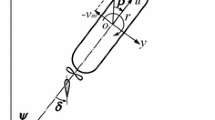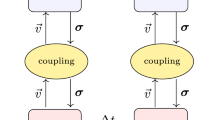Abstract
Bionic undulating fins, inspired by undulations of the median and/or paired fin (MPF) fish, have a bright prospective for underwater missions with higher maneuverability, lower noisy, and higher efficiency. In the present study, a coupled computational fluid dynamics (CFD) model was proposed and implemented to facilitate numerical simulations on hydrodynamic effects of the bionic undulating robots. Hydrodynamic behaviors of underwater robots propelled by two bionic undulating fins were computationally and experimentally studied within the three typical desired movement patterns, i.e., marching, yawing and yawing-while-marching. Moreover, several specific phenomena in the bionic undulation mode were unveiled and discussed by comparison between the CFD and experimental results under the same kinematics parameter sets. The contributed work on the dynamic behavior of the undulating robots is of importance for study on the propulsion mechanism and control algorithms.
Similar content being viewed by others
References
Bandyopadhyay P R. Biology-inspired science and technology for autonomous underwater vehicles. IEEE J Ocean Eng, 2004, 29(3): 542–546
Bandyopadhay P R, Castano J M, Rice J Q, et al. Low speed maneuvering hydrodynamics of fish and small underwater vehicles. J Fluid Eng, 1997, 119: 136–144
Bozhurttas M, Tangorra J, Lauder G, et al. Understanding the hydrodynamics of swimming: From fish fins to flexible propulsors for autonomous underwater vehicles. Adv Sci Technol, 2008, 58: 192–202
Hu T J, Shen L C, Low K H. Bionic asymmetry: From amiiform fish to undulating robotic fins. Chin Sci Bull, 2009, 54(4): 562–568
Yoseph B C. Biomimetics—Using nature to inspire human innovation. Bioinspir Biomimet, 2006, 1(1): 1–12
Sfakiotakis M, Lane D M, Davies B C. An experimental undulating-fin device using the parallel bellows actuator. In: IEEE Internatioal Conference on Robotics and Automation, 2001, Seoul, Korea
Epstein M, Colgate J E, Maclver M A. A biologically inspired robotic ribbon fin. In: IEEE/RSJ International Conference on Intelligent Robots and Systems, Workshop on Morphology, Control, and Passive Dynamics, 2005, Edmonton, Canada
Low K H. Design, development and locomotion control of bio-fish robot with undulating anal fins. Int J Robot Auto, 2007, 22(1): 88–99
Hu T J, Shen L C, Lin, L X, et al. Biological inspirations, kinematics modeling, mechanism design and experiments on an undulating robotic fin inspired by gymnarchus niloticus. Mech Mach Theory, 2009, 44(3): 633–645
Zhang Y H, He J H, Zhang S W, et al. Research on biomimetic fish fin driven by NiTi shape memory alloy (in Chinese). Robot, 2007, 39(3): 207–213
Low K H. Modelling and parametric study of modular undulating fin rays for fish robots. Mech Mach Theory, 2009, 44(3): 615–632
Toda Y, Ikedab H, Sogihara N. The motion of a fish-like underwater vehicle with two undulating side fins. In: The Third International Symposium on Aero Aqua Bio-mechanisms (ISABMEC 2006), 2006, Ginowan, Japan
Bandyopadhyay P R. Maneuvering hydrodynamics of fish and small underwater vehicles. Integrat Comp Biol, 2002, 42: 102–117
Triantafyllou M S, Hover F S, Techet A H, et al. Review of hydrodynamic scaling laws in aquatic locomotion and fishlike swimming. Appl Mech Rev, 2005, 58: 226–236
Xie H B, Shen L C. Collaborative modeling of underwater vehicle dynamic system (in Chinese). J Syst Simul, 2007, 19(9): 2130–2133
Xie H B, Zhang D B, Shen L C. Collaborative simulation based on MATLAB/Simulink and FLUENT (in Chinese). J Syst Simul, 2007, 19(8): 1824–1827
Wang G M, Shen L C, Hu T J. Kinematic modeling and dynamic analysis of the long-based undulation fin of gymnarchus niloticus. In: The 9th International Conference on the Simulation of Adaptive Behavior, 2006, Roma, Italy
Hu T J. Undulation adaptability theory and control for the biomimetic undulating fins (in Chinese). Dissertation of Doctoral Degree. Changsha: National University of Defense Technology, 2008
Shirgaonkar A A, Curet O M, Patankar N A, et al. The hydrodynamics of ribbon-fin propulsion during impulsive motion. J Experim Bio, 2008, 8: 3490–3503
Zhou H, Hu T J, Xie H B, et al. Computational hydrodynamics and statistical modeling of biologically inspired undulating robotic fins: A two-dimensional study. J Bio Eng, 2010, 7(1): 66–76
Xie H B. Design, modeling, and control of bionic underwater vehicle propelled by multiple undulatory fins (in Chinese). Dissertation of Doctoral Degree. Changsha: National University of Defense Technology, 2006 2972–2975
Author information
Authors and Affiliations
Corresponding author
Rights and permissions
About this article
Cite this article
Zhou, H., Hu, T., Xie, H. et al. Computational and experimental study on dynamic behavior of underwater robots propelled by bionic undulating fins. Sci. China Technol. Sci. 53, 2966–2971 (2010). https://doi.org/10.1007/s11431-010-4146-6
Received:
Accepted:
Published:
Issue Date:
DOI: https://doi.org/10.1007/s11431-010-4146-6




